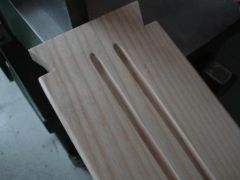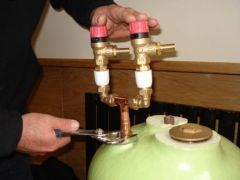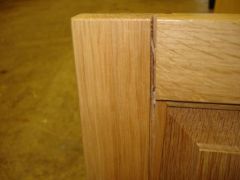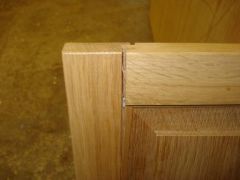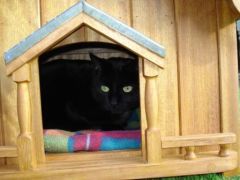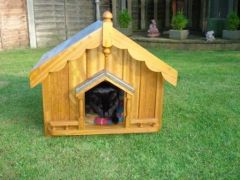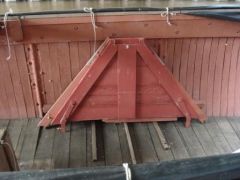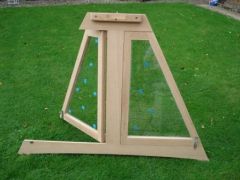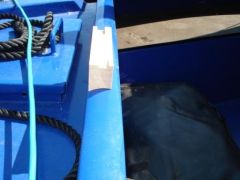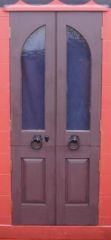

Mike Jordan
Member-
Posts
537 -
Joined
-
Last visited
Content Type
Profiles
Forums
Events
Gallery
Blogs
Store
Everything posted by Mike Jordan
-

Carpet advice required please Guys !!!!!!!!!!!!!!!
Mike Jordan replied to brum's topic in Boat Equipment
I have no complaint about the tough long lasting qualities of Flotex, I've had it last about 16 years as a deck covering subjected to all sorts of abuse. The observation was that its totally waterproof qualities may not be what is needed inside a boat with moisture in the bilges under the cabin. The same goes for the proposition to put down plastic sheeting beneath carpet. -

Carpet advice required please Guys !!!!!!!!!!!!!!!
Mike Jordan replied to brum's topic in Boat Equipment
Ive seen Flotex used on the roof of an old timber top to make it waterproof, and Ive used it several times on the rear decks of a cruiser stern boats. Its very hard wearing but not so good inside a boat. -

Carpet advice required please Guys !!!!!!!!!!!!!!!
Mike Jordan replied to brum's topic in Boat Equipment
If there is any chance of moisture in the bilges the use of a plastic sheet can cause condensation on the bottom of the sheeting wetting the timber floor. I caused myself this problem in the past when I used Flotex carpet inside a boat. This might even be the reason that the underlay was omitted? The current practice of fully welding the rear bulkhead to stop water from the engine room running under the accommodation also prevents any small leakage from pipework or condensation running back to be pumped out, many (but not all)boats have a small amount of water under the floor wetting the ballast and causing problems. -

Sign Writing - Marking Out?
Mike Jordan replied to NorthwichTrader's topic in Boat Building & Maintenance
The method of using chalk can be improved by using carbon paper in place of chalk. It makes a far better set of lines to follow with the paint. After the letters are outlined, moving the paper template down and to one side will give the lines for the shadow if needed and save on a drawing job. -
If there is such a thing as an average in back boilers, its a steel box about the size of a cigar box ( very approximately) at the back of the firebox. Its possible to heat a circuit of radiators from this either by gravity circulation or using a pump, it makes good sense to me to make full use of the available heat from a solid fuel stove. The part of your suggestion that worries me is the implication that you will leave the stove to fend for itself all day every day. Your stove is affected by the direction and strength of the wind which can make the fire burn faster or slower. In theory the modern insulated flues are safer than just a length of steel pipe as used in the past. I may be overcautious, but my preference would certainly be to trust the heating of the boat to a gas boiler when you are not on board and use the solid fuel burner while the boat is occupied. I have used this system in past years using the Alde comfort boiler which used no power to give background warmth and only uses about 2 watts to circulate water to the rads for full heating. You will hear claims that the boiler uses a lot of gas but I have always found them as efficient as any other boiler. Just my thoughts, I'm sure you will hear others!
-
The Royal Navy are reputed to specify that frames and plating are welded all round (presumably for strength) so every vessel tends to look like a hungry horse! You do see the same effect on some narrow boats when the plating and frames have been too enthusiastically welded. The weld marks that show through where the superstructure ribs have been welded to the plating are easy to grind off but some builders don't bother. The worst I have seen have been on the roofs of aluminium boats where the effect can be very unsightly.
-

Toilet idea... (another one of my potentially stupid ideas)
Mike Jordan replied to Doodlebug's topic in Boat Equipment
How are you proposing to tell how full the container is ? and what will happen to the contents of the filler pipe when you remove the jerry can for emptying. Just think for a second about an inevitable overfilling of the jerry can and vent pipe. Cassette toilets make the job reasonably acceptable, a lot of experience and thought have gone into their design. A spare cassette can't possibly be expensive enough to make this idea worth considering! -
In the sheet widths used for narrow boats you can order lengths the length of the lorry bed if you wish, this is very handy for use as a 10mm thick base plate since this can be slid off the lorry straight into the build position and only one weld will be required. The folded side plates for the hull can normally only be cut to a length that will fit the machine used to put the folds in them, not many machines exceed 4 metres and many are shorter. If there are no folds in the design then you can use decoiled steel in long lengths and avoid welding joints and the distortion this can cause. The size of plates used is usually limited by the equipment available to lift them into place on the shell.
-
I think the easiest way of remembering it is that in a single width flight, with any number of locks, the first lock needs to be in your favour and all the rest against you. In a double width flight a single narrow boat can pass a pair going the other way ( assuming good sense and a bit of shuffling to the side)
-
From the album: Dog box Vents
8mm grooves in top face of top plank for concealed wiring to tunnel lanp and horn. -
From the album: Dog box Vents
Twin relief valves fitted to a vertical calorifier. -
I've never bought one but have made similar devices for getting free heat from the engine, only a glorified car heater really, but very effective. There was an article in the December 2011 issue of Waterways World. If you look on the WW website and search for my name you will be able to download the article for a small charge. Mike Jordan.
-
catweasel, on 06 Dec 2013 - 09:45 AM, said: This is purely out of curiosity, but I assume on a diesel engine with the piston at TDC this is enough to hold the valves up whilst collets are removed? Yes the valves are very close to the piston crown with the crank at TDC. No special tools were required just a large washer on the rocker shaft bolt and a couple of ring spanners to press down on the springs, a third hand would be great but you can manage. I was aware that the seals would be unlikely to have any real benefit but didn't dream that they would turn on me! it took months for the oil deposits to clear from the silencer and exhaust. Like most daft moves it only took a minutes lack of thought in the first place.
-
Its not always a good idea to put seals on the exhaust valve stems. I fitted the seals from a non original gasket maker some time ago and was soon in trouble. The seals welded themselves to the stems by the heat and then went up and down with the valves, the result was a perfect little pump which pushed oil down the valve guide and out of the exhaust. I managed to remove the seals without removing the head by using the TDC method. Its a fiddle to do and I put the stern cover over the boat to stop any collets which flew off the stems from finishing up in the water. The seals on the inlet valve stems worked as expected and caused no trouble. I am sure that the seals in my kit were cheap rubbish but I have since noticed that quite a few of the 1.5 & 1.8 BMCs don't have seals on the exhaust valve stems.
-
From the album: Dog Box
Door joints destroyed by expansion of a solid timber panel. -
From the album: Dog Box
Solid oak doors with raised panels and not enough allowance for expansion of the panel. -
No one has mentioned cork tiles, I've used the pre finished ones on several boats and found the results good, they are warm to the feet, easy lay, keep clean, and hard wearing. I'm not sure if they have now gone out of fashion in domestic use. Flotex is the most hard wearing stuff I've ever used, its surprisingly good for use outside on the decks of a cruiser stern, but like any waterproof material when used inside, it can cause any moisture in the bilges to condense on the underside and wet the sub floor. I think that this may be one of the hidden advantages of floor coverings like carpet that are porous and allow moisture to escape. As already mentioned engineered flooring moves a little according to moisture levels. Solid oak flooring is cheaper than the engineered stuff but can cause serious damage when it expands, a fitter who is not aware of the different levels of moisture in a boat may easily be caught out! There are two photos at the top of the page showing what happened to the doors on a brand new boat whose builder knew very little about timber movement!this happened to every door in the boat during the first winter.
-
From the album: Deck Lights
-
From the album: Deck Lights
Detached Country Residence -
Hello Darren I have just uploaded a photo of an old cratch board. Its at the top of the page and in my gallery ( for the simple reason that I have no idea how to put it here!) It was in the hold of an unconverted boat some years back, sorry no idea of the boat name. Its a far cry from the posh glazed opening ones I make today. I have made a single similar one for a repro boat, that was boarded in much the same way with bead and butt tongue and groove boards in ash for painting. Hope I'm not barking up the wrong tree and that this is of some use. Mike.
-
From the album: Deck Lights
A simple cratch board showing fitting method with steel tongues and birdsmouth. -
Light red or dark red Meranti is one of the budget hardwoods, regrettably its life expectancy is little better than you would get from a decent softwood. Having said that you can get reasonable results with varnish or oil based varnish both of which have strengths and weaknesses. Your suggestion of oil finishing would be ok providing that you do regular coatings and bear in mind that the dirt that falls on the timber will tend to stay there rather than washing off as with varnish. If you use Danish oil your will get a better result since this is really a mixture of oils with a varnish content which puts a surface film on the timber. Exterior quality varnish or yacht varnish will give a good waterproof surface and is flexible enough to cope with the movement of the timber. It usually fails in time at the joints or other areas where water can penetrate or lie on the surface or in between the cratch board and the steelwork. Whichever system you choose, exterior woodwork needs regular checks and early maintenance. If asked, I always advise oil based exterior varnish with the first coat thinned 50% with white spirit to soak in well and give a good key to following coats. I tend not to trust the water based vanishes, although we are being forced towards their use by EU rules. Water based paints do seem to work well on cars though! It helps if you follow good joinery practice and ensure that all exterior edges have a weather slope to shed rainwater (9 degrees is the recommended minimum) its also sensible to put the glazing beads on the inside rather than out in the weather! If you want a timber that is extremely weather resistant then Iroko is the one to chose next time, it contains a natural oil which makes it last for years even if you neglect it totally. I hope this missive hasn't depressed you, best of luck with the project. Mike.
-
From the album: Deck Lights
Outward opening glazed board with double curve to base. -
From the album: Deck Lights
Sample block used to test shape of double curve -
From the album: Deck Lights
Gothic style stable doors in softwood

